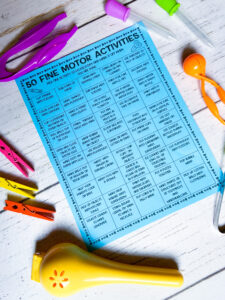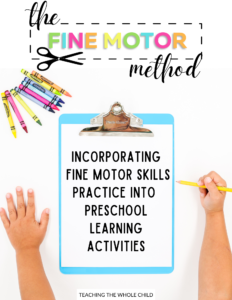
- Fine motor skills involve the small muscles in the hand, wrist, and fingers.
Every task that includes the small muscles in the hand, wrist, and fingers is a part of fine motor development. This includes many skills including picking up small objects, holding utensils, hanging onto equipment on the playground, and throwing and catching a ball. There are also other tasks that go along with fine motor skills that include other parts of the body as well. This includes skills such as crossing the midline and hand-eye coordination.
2. Fine motor skills are an ESSENTIAL part of early childhood development.
There are different domains of early childhood development that include gross motor (large muscles), speech and language, social-emotional, cognitive (learning, problem-solving, memory), and fine motor skills. As an early childhood educator, caregiver, or parent, it is important to understand and support young children in all of these areas. Fine motor skills are a very important piece of the “puzzle” and help to lay the foundation for whole-child development.
3. Fine motor skills can be strengthened by using various materials and being involved in activities at both home and school.
There are many different activities that can be done at home and school in order to help strengthen a child’s fine motor skills. These activities include small objects that can be used as manipulatives as well as tools that can be found around your house or classroom. Here is a handout that includes 50 different activities to strengthen fine motor skills.

4. Independence fosters fine motor skill development.
Allowing a child to complete tasks independently can help strengthen fine motor skills. Even if the child cannot complete the job, it is still beneficial for them to try. These tasks can be done at both school and home and include activities like buttoning buttons, zipping, snapping clothes, opening snacks, using eating utensils, etc. To help facilitate this independence, it is important to give tasks to children that are developmentally appropriate for them. To foster independence they should be dressed in clothes that they can easily put on and take off by themselves. An example of this would be wearing elastic pants and shoes with velcro. Completing these tasks independently not only aids with fine motor development, but social-emotional development as well.
5. Children need to develop strong fine motor skills BEFORE they start writing.
Writing requires strong hand muscles and good hand-eye coordination. Young children need to practice these skills before they pick up a pencil. Prewriting activities including writing in the air, writing in sand, and coloring with crayons are also great activities that build fine motor skills. In addition to fine motor skills, core strength, knowledge, and resilience are also necessary for successful writing.

Want to Learn More?
The Fine Motor Method: Incorporating Fine Motor Skills Practice into Preschool Learning Activities
If you are a preschool teacher or parent and would like to learn more about fine motor skill development and how to create activities in your classroom that foster this development, then check out this fun professional development course!












